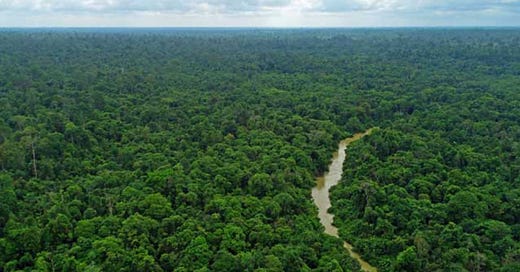
The Harapan Rainforest Project covers an area of 100,000 hectares of extremely biodiverse lowland rainforest in Sumatra, Indonesia. Without the project, the forest would be destroyed. Two former logging concessions operated in the area. It is bordered by oil palm plantations and active logging concessions. Yet it is still relatively intact.
Harapan is home to 20 Sumatran tigers, almost 300 bird species, gibbons, elephants, clouded leopard, tapirs and sun bears. But the project has run into criticism. Local people accuse the project developers of kicking them out of the project area. They also accuse them of intimidating them.
REDD-Monitor has repeatedly asked John Lanchbery at the Royal Society for the Protection of Birds in the UK for a response to these criticisms. The following is a statement received from Lanchbery on 15 September 2009, in response to the reports from Sumatra about problems for local people:
We are surprised that you have taken such a strong line in portraying Harapan Rainforest as a bad example of REDD practice. To be clear, Harapan Rainforest is a conservation and restoration project and is not driven by carbon. It aims to conserve and restore one of the last remnants of dry lowland forest in Sumatra, one of the most biodiverse habitats in the World, and a key element of sustainable livelihoods for local people. It does not now receive, nor has it ever received any carbon credits. Conserving and restoring Harapan Rainforest will undoubtedly reduce emissions from deforestation and sequester carbon. We are considering whether to use carbon income to supplement our work but, if we do, it will be in support of the activities that we are already pursuing. It will not influence our core aims.
We are dedicated to gaining the support of local people in and around the forest and helping to support sustainable livelihoods for them. This is essential for any forest project anywhere, both morally and practically – if only because without active local support the project will fail. However, the social situation on the ground is complex, including indigenous communities, long-established local communities, and the very recently arrived settlers shown in the SPI (Federation of Indonesian Farmers) video. Developing a good working relationships with these varied communities is bound to be challenging but we are dedicated to doing so, and feel that we are starting to make progress. The RSPB and its Partners respect legitimate rights of indigenous and local peoples and reject the allegation of intimidation.
Finally, I should add that I am a policy person based in the UK, the principal climate change adviser at the RSPB. The Indonesian management team of Harapan Rainforest is much better placed to comment on the site-specific management of Harapan Rainforest. I am sure the team would be happy to provide you with more information, if you wish.
REDD-Monitor first mentioned the Harapan project after Lanchbery described it as “interesting from a REDD point of view”, during a presentation at a side event at Poznan in December 2008. The side event title was “Innovative financing for forest-based climate mitigation”.
Lanchbery states that the Harapan project is “not driven by carbon”. He explains that, “We are considering whether to use carbon income to supplement our work but, if we do, it will be in support of the activities that we are already pursuing. It will not influence our core aims.”
There are at least two problems with this. First, if the Harapan Rainforest Project is already pursuing the activities that are going to reduce carbon emissions, how can the project possibly be considered to be “additional”? This would be a classic example of using carbon finance to fund something that would have happened anyway. Any carbon credits from this project would guarantee an increase in greenhouse gas emissions. Second, if the Harapan Rainforest Project has to start measuring carbon stored in the forest it will inevitably influence the project’s core aims. The project will have to spend more money on carbon consultants. Staff will have to learn new skills and devote more time to measuring carbon than they are currently doing. That means spending less time running the conservation and restoration aspects of the project – and less time to address the problems that local communities are facing as a result of the project. This is precisely what happened with the world’s first forestry offset project, the CARE-AES project in Guatemala.
But the worst aspect of Lanchbery’s comment is that it provides little reassurance that the problems of local people are going to be adequately addressed – whether or not carbon finance is involved. The people who are complaining may well be “very recently arrived settlers”, but just because they arrived recently does not mean that they have no rights. Lanchbery does not say where they came from – whether they were evicted from nearby concessions, for example.
Neither does the project website make any mention of how the project is attempting to address the problems that some of the local communities around the project are facing. The World Bank’s Tony Whitten visited Harapan recently, as part of the preparation for a GEF project with the catchy title of “Promoting Sustainable Production Forest Management to Secure Globally Important Biodiversity”. The project will be carried out with Burung Indonesia, one of the organisations running the Harapan project. Whitten’s blog post about the visit fails to mention local people.
REDD-Monitor will follow up on Lanchbery’s suggestion of contacting the Indonesian management team of Harapan Rainforest and looks forward to posting the response.





Comments following the original post on REDD-Monitor.org are archived here: https://archive.ph/co9fv#selection-741.4-741.13